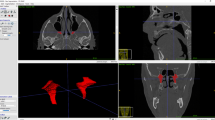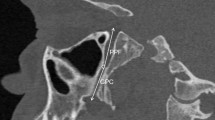Abstract
Purpose
Pterion is defined as a junction of temporal, frontal, parietal, and sphenoid bones. In newborns, pterion may be defined as a region that shows variability in the exact location because of the lack of complete bony structure. The aim of this study is to define the topographic anatomy of this important surgical point, pterion, and the variability of its localization on craniums of newborn cadavers.
Methods
Our study was performed using 35 term neonatal cadaver specimens. We measured the distances between the pterion and other critical points and used a scale diagram for the definition of pterional area.
Results
Our scale diagram showed that pterion is mostly localized in regions c, d, e, and f on the length and regions 2, 3, 4, and 5 on the width. Localization was not observed in regions a, b, g, and h, and in areas of squares 1 and 6. The most observed localization of pterion was the e4 (24.28%) area.
Conclusion
This study provides a detailed knowledge on localization of this important point, pterion, which will be useful for the clinicians at operation planning and treatment stages, serving for the success in surgery in the presence of this variable topographic cranial anatomy.




Similar content being viewed by others
References
Bozbuga M, Ozturk A, Ari Z, Sahinoglu K, Bayraktar B, Polat G, Gurel I (1998) Surgical anatomy of the temporal bone and measurements of the skull bas efor transpetrosal approaches. Okajimas Folia Anat Jpn 75(1):33–39
Cheng WY, Lee HT, Sun MH, Shen CC (2006) A pterion keyhole approach for the treatment of anterior circulation aneurysms. Minim Invasive Neurosurg 49(5):257–262
Das S, Suri R, Kapur V (2005) Anatomical observations on os inca and associated cranial deformities. Folia Morphol (Warsz) 64(2):118–121
Ersoy M, Evliyaoglu C, Bozkurt MC, Konuksan B, Tekdemir I, Keskil IS (2003) Epipteric bones in the pterion may be surgical pitfall. Minim Invasive Neurosurg 46(6):364–365
Feng WF, Qi ST, Huang SP, Huang LJ (2005) Surgical treatment of anterior circulation aneurysm via pterion keyhole approach. Di Yi Jun Yi Da Xue Xue Bao 25(12), 1546-8:1551
Lang J (1983) The fronto-temporal region and its clinically important distance from the optic nevre. 1. the fronto temporal region. Neurochirurgia (Stuttg) 26(6):161–163
Lang J (1984) The pterion region and its clinically important distance to the optic nevre. 2. Pterion region, distance to the optic nevre, dimensions and shape of the recess or the temporal pole. Neurochirurgia (Stuttg) 27(2):31–35
Moore KL, Dalley AF (1999) Clinically oriented anatomy, 4th edn. Lippincott Williams & Wilkins, Baltimore, pp 836–842
Nathal E, Gomez-Amador JL (2005) Anatomic and surgical basis of the sphenoid ridge keyhole approach for cerebral aneurysms. Neurosurgery 56(Suppl 1):178–185 discussion 178-85
0guz O, Sanli SG, Bozkir MG, Soames RW (2004) The pterion in Turkish male skulls. Surg Radiol Anat 26(3):220–4
Potapov AA, Yeolchiyan SA, Tcherekaev VA, Kornienko VN, Arutyunov NV, Kravtchuk AD, Shahinian GG, Likhterman LB, Serova NK, Eropkin SV (1996) Removal of a craniao-orbital foreign body by a supraorbital-pterion approach. J Craniofac Surg 7(3):224–227
Sakovich VP, Kolotvinov VS, Shamov A (2000) The surgical treatment of intracranial aneurysms from the pterion approach using small trephining openings. Zh Vopr Neiokhir Im N N Burdenko (1): 3–6; discussion 7
Saxena RC, Bilodi AKS, Mane SS, Kumar A (2003) Study of pterion in skulls of awadh area-in and around Lucknow. Kathmandu Univ Med J (1):32–33
Standring S, Ellis H, Healy JC, Johnson D (2005) Gray’s anatomy, 39th edn. Elsevier Churchill Livingstone, London, pp 442–471
Urzi F, Ianello A, Torrisi A, Foti P, Mortellaro NF, Cavallaro M (2003) Morphological variability of pterion in the human skull. Ital J Anat Embryol 108(2):83–117
Author information
Authors and Affiliations
Corresponding author
Rights and permissions
About this article
Cite this article
Aydin, M.E., Kopuz, C., Demir, M.T. et al. Localization of pterion in neonatal cadavers: a morphometric study. Surg Radiol Anat 32, 545–550 (2010). https://doi.org/10.1007/s00276-009-0615-7
Received:
Accepted:
Published:
Issue Date:
DOI: https://doi.org/10.1007/s00276-009-0615-7




